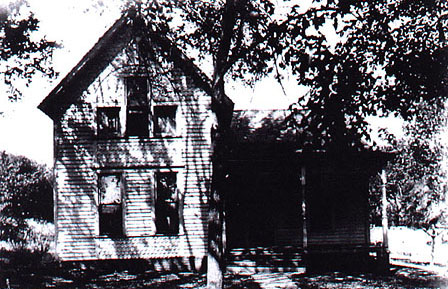
This is the stuff slumber party folklore is made of. You’ve probably heard the story, perhaps even at a slumber party. Evil incarnate once waited in the attic for a family to retire. Then it slunk down the stairs to murder them all.
It really happened once, in Villisca, Iowa in 1912, in an event called the Villisca ax murders. And it happened during a slumber party. Ten-year-old Mary Katherine Moore had invited her friends, Lena and Ina Stillinger, to spend the night. The next morning the family of six, along with the two young guests, were all found the bludgeoned in their beds. The killer was never caught. Yet the story lives on as a slumber-party myth, whispered in fear between children curled up in their sleeping bags.
Here’s what really happened. Cal Schoonover joins us today with a guest blog about the Villisca ax murders based entirely on witness testimony.
Sometime the truth is just as frightening as the legend.
Just a “normal” house
The wood framed white house sits on a quiet residential street in the small town of Villisca, Iowa. At a quick glance one may not see anything out of the ordinary, but as the sun sets, the house becomes dark. There are no lights on in the house, the absence of electricity makes this impossible. Upon a closer look one will see the house is not so ordinary after all, its curtained windows prevent anyone on the outside from seeing in and the outhouse in the backyard leaves the impression it belongs to another time. This was once an ordinary house, but this is no longer the case as this house has secrets. Dark secrets and to this day holds the identity of a murderer within its walls.
Villisca, Iowa in 1912 was flourishing with businesses and its 2,500 residents did not seem to have trouble finding employment if needed. Several dozen trains entered and left the town throughout the day, causing the only disturbance to the normal quiet town. There was also an armory, a first of its kind, built by the local townspeople and paid entirely by taxpayer money. Times were good in the tight knit community of Villisca; at least it was until June 10, 1912 when the town became forever known for the horrific Axe Murders of an entire family.
The Moore family, victims of the Villisca ax murders
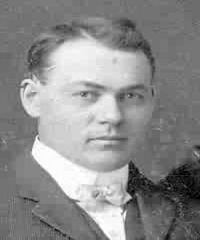
In 1912 Villisca, Josiah B. Moore was the town’s most successful businessmen. Born in 1868, Josiah or “Joe” as he was called by many, was a success in just about everything he did. He married Sarah Montgomery on a cold December day in 1899 at Sarah’s parents home. The couple went on to have four children; Herman, Katherine, Boyd and Paul. Together, Josiah and Sarah built a nice life for their family in the thriving town of Villisca.
Although Villisca could be buzzing with people who were attached to the railroads, overall crime was rather low. Residents were not afraid to leave their homes unlocked and windows open at anytime of day. Crime existed of course, but nothing like people see in larger cities and until the night of June 10, 1912 when the town was rocked by the murder of not one, but eight people.
The fateful day of June 9
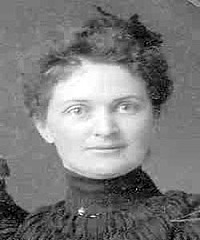
Josiah and Sarah woke early on Sunday, June 9 to get the kids and themselves ready for church. It would be a busy day for the Moore’s at the town’s Presbyterian Church, with morning services and other events that included the annual Children’s Day Program. The Children’s Program was to begin at 8:00 p.m., which was, according to witnesses led by Sarah Moore. By 9:30 the exercises were finally over, and the exhausted towns people of Villisca headed home to settle down for the night. The Moore’s children, mainly Katherine was not ready to throw in the towel quite yet. She had such a great time with her friends, Lena and her younger sister Ina Stillinger, that Katherine asked her dad if the Stillingers could spend the night. Not wanting to spoil his daughter’s fun, Josiah called the Stillinger home to check to make sure Lena and her sister were able to stay.
A slumber party
After a few rings a voice on the other end was heard. It belonged to Blanche, the eldest daughter of Joseph and Sara Stillinger. Her parents “were outdoors now,” but she would pass on the message to her parents. Assuming everything would be okay, Josiah and Sarah gathered up all the kids and began the walk home. The Moore’s, like most people in Villisca did not own a car but the church was only three blocks away from their home. A short walk on the cool, but damp night made the walk somewhat enjoyable.
Given the distance from church to the Moore home, the family should have arrived between 9:45 and 10:00 p.m. What exactly happened upon arrival will never be known for sure. No one could imagine that when the Moore family left church that night, it would be the last time the family was ever seen alive.
An ominously quiet house
Mary Peckham rose out of bed around 5:00 a.m. on the morning of June 10; wanting to get a start on household chores so she stepped out to hang her laundry outside. The only noise was the sound of birds chirping in the dark sky, nothing seemed out of the ordinary. Peckham lived next door to the Moore’s for many years and like many small- town residents, people’s routines did not go unnoticed. There was “absolutely no noise,” throughout the night Peckham later recalled. Although she had not seen the Moore family arrive home the night before since she had gone to bed around 8:00 p.m., she could not believe the family would have been out late.[i]
By 7:00 a.m. there was still no sign of activity around the Moore household. Concerned, Peckham walked over to the “unusually still” house and knocked on the door. No answer. She went around to the back of the house and saw none of the Moore’s livestock had been taken care of yet. Peckham let the chickens out of their cage but did not untie the other livestock. Concerned, Peckham went back home and called Josiah’s brother Ross. Maybe, she thought, something happened out of town and the Moore family had to attend to at the last minute? While on the phone with Jesse, Ross’s wife, movement near the Moore’s barn caught Peckham’s attention. From where Peckham stood in her home she could see it was Ed Selley, who worked for Josiah, enter the barn where the horses were.[ii]
A brother discovers the Villisca ax murders
After hanging up the phone, Peckham wondered over to the Moore’s barn to talk to Selley. Maybe he knew something. Within minutes, Ross arrived and found a spare key to his brother’s house. Peckham followed Ross up to the front door and waited on the front porch while Ross went inside to have a look around. Nothing seemed out of the ordinary until he opened the bedroom door near the parlor. The scene was horrific and something Ross would never forget. The once white sheets on the bed were now stained red with the blood of two small kids. At a fast pace Ross came back to the porch and told Peckham to call the sheriff. “Something awful” has happened![iii]
No sign of forced entry
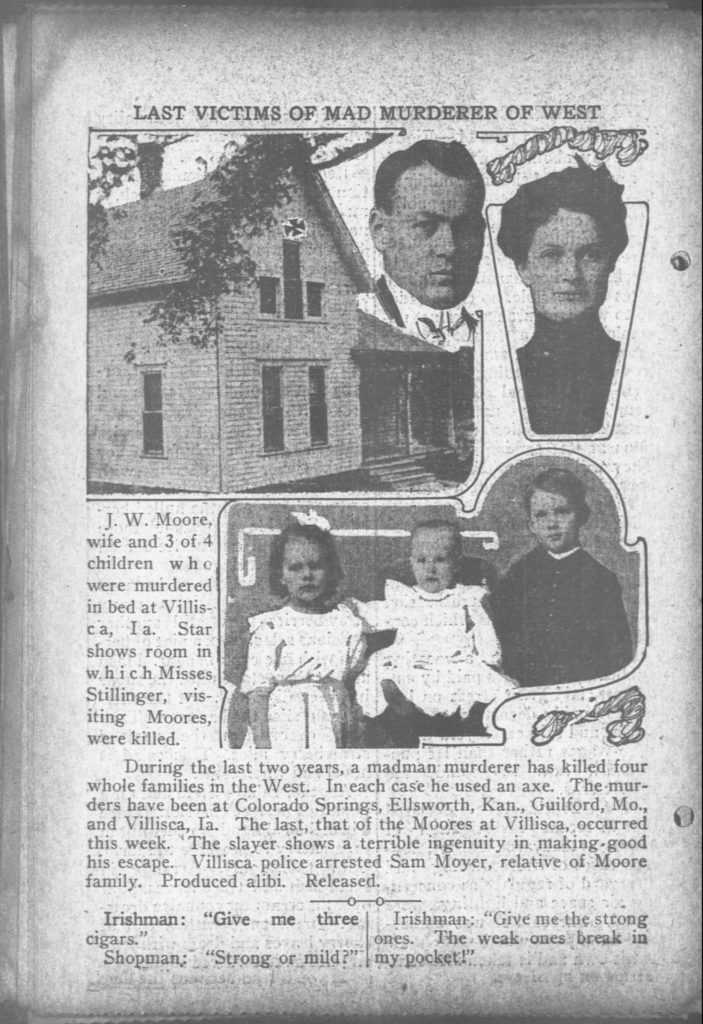
Sheriff Hank Horton arrived at the Moore home and was greeted by Ross and Mary Peckham. Moore led Horton to the first bedroom where the two Stillinger girls slept. Horrified at the sight, the two men then slowly made their way upstairs to look in the other bedrooms. All dead. All still in their beds, covered with blankets and lots of blood. Sheriff Horton and Ross looked around the house briefly, noting that all windows and doors remained locked. Mary Peckham, who entered the first floor of the home noticed the doors needed to be locked from the inside with a key. No key was noticed. There was no sign of forced entry either which is a strong indication the killer was already inside the house when the Moore’s arrived. But how?
Medical attention was not needed, Sheriff Horton knew this but went to get Dr. J. Clark Cooper anyway. “Come with me,” Horton said to Cooper after arriving at Cooper’s office. Wondering why Horton appeared so anxious, Dr. Cooper asked why? “Joe Moore and all his family were murdered in bed.” Shocked at what he heard, Cooper went along with Horton. Waiting for them were Dr. Hough and Mr. Ewing, the towns minister. [iv]
The lamp upstairs: a clue to where the murderer waited
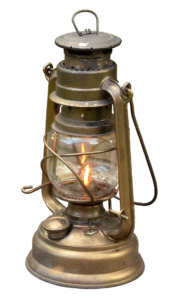
Noting seemed to be out of place, there was no sign of a struggle. Upon entering the first-floor bedroom “All we could see was an arm of someone sticking out from under the edge of the cover,” Cooper said. There were large amounts of “blood on the pillows.” Cooper slowly approached the bed and lifted the cover and saw what he “supposed was a body.” Cooper told the inquest he did not, along with the other men in the room know who the two children were except they were dead. They stepped out of the bedroom and went upstairs. At the top of the stairs sat a lamp on the floor. Horton reached down and moved the lamp out of the way and the men continued into Josiah and Sarah’s bedroom. Later Horton determined that the killer had used the lamp for light and left it where it was found.
“Here is Joe,” Horton said pulling the cover down. Both Josiah and Sarah were clearly dead, their faces “beaten in.” Cooper left the room and went to check the condition of the Moore’s kids. They also were dead, their blankets stiff with dried blood that was in the process of becoming a jelly like substance. When asked at the inquest, Cooper estimated the family had been dead for at least 5 to 6 hours.[v]
An unsolved case and a town changed forever
All in the house had been killed the same way, by an axe that was found in the room the Stillinger girls slept. Traces of blood were found on it although there was an attempt to wipe it clean. Investigators made note that none of the clothing the victims wore had any holes in it from the axe. The bodies had been covered after they were murdered, and gouge marks were found on the ceiling where the axe blade came into contact as the killer swung the weapon. It was also noted there was a pan of blood stained water on the kitchen table along with a plate of uneaten food. Had these murders been committed today, the killer would almost for certain been caught, but in 1912 this was not so. Finger printing was rather new and DNA testing was a long way off. While there were suspects in the case, no one was ever brought to justice for these crimes. There never will be either. The town of Villisca, once a small friendly town were people knew others business changed after June 10, 1912. Doors and windows were no longer left unlocked, people opened carried guns and feelings old friends had for one another changed.
Thank you, Cal Schoonover!
More on the Villisca Ax Murders
The Villisca Ax Murder House offers tours and overnight stays. Click on the link to find more information about the case, view photos, and make a booking. An extra thanks to the Villisca Ax Murder House for allowing me to publish some of its photographs.
For extra reading, a recent book covers the topic. Author Bill James suggests a solution to the Villisca ax murders were in his 2017 true crime book, The Man from the Train.
About Cal Schoonover

Cal Schoonover holds a BA in 18th and 19th century Military History and is working on his MA in history with a concentration on the Civil War. He plans on pursuing his PhD by the fall of 2019. His articles have appeared in Crime Magazine, the Surratt Courier and Emerging Civil War. com. He lives in Wisconsin with his son James.
[i] Peckham testimony, June 11, 1912.
[ii] Ibid
[iii] Ibid
[iv] Dr. J. Clark Cooper testimony, June 11, 1912.
[v] Ibid




While I have not read Mr. Schoonover’s book, I just finished Bill James’ “The Man From the Train” and thoroughly enjoyed it. It was written in a different style. It’s as if the reader is having a one-on-one conversation with Mr. James as opposed to reading a book. He and his daughter and co-author, Rachel, introduce an interesting suspect at the end of the book and provide compelling reasons as to why they are sure he’s the axe murderer.
One thing I wish they would have expounded on was the hiatus the killer supposedly took. If their guy was the right man, they may could have proven that he was in jail, etc. during this time. That would have provided more credence to their suspected killer. But they did not.
On a side note, my fiance, Mark, lives four hours from Villisca, and it has always been our list of places to visit. We just haven’t done so yet. However, we did see the axe temporarily on display at the State Historical Museum in Des Moines. Talk about creepy!
The Man From the Train is on my reading list, Shelby, so thanks for the tip. It was one of the finalists for an Edgar, so I know it must be good.
Gee, if you do visit Villisca, that would be a blog post worth (if you don’t think the subject fits on your website, you’d be welcome to write a guest blog for mine!). I had no idea the axe was temporarily on display. No doubt about it — that is creepy!
Thanks for commenting.
Arrghh! I meant to say that I have not read Mr. Schoonover’s work, not book.
Anyway, a good documentary on the Villisca murders is called, “Villisca: Living with a Mystery.” It’s from 2004 but at 116 minutes, it is highly detailed and very well done. I especially appreciated the contextual framework the writers laid regarding the background of Villisca. It I remember correctly, they suggest another suspect different than the James’ guy. I’ll have to go back and watch it again.
http://www.villiscamovie.com
Let me know what you think of “The Man From the Train.” I think you will especially appreciate the fact that the authors thinly suggest that their guy went back to Germany after Villisca and may have even committed one of the famous murders over there. Hey, maybe an idea for your second book? 😉
I see that the Villisca movie is available on Netflix, so I’m going to try to watch it there. Thanks for the tip, Shelby! I’ll also eventually get to “The Man from the Train” and I’ll let you know what I think. The Germany connection sounds fascinating, so I might just check it out!
This was interesting as usual, and I can kind of picture my home town of Mt Prospect, in Illinois, as perhaps a similar town. I’m sure back then they also did not lock their doors and windows were left wide open if it was hot outside. I’ve read old newspapers from Mt Prospect and crime was rare. The main question I have is why were there no holes in their clothing? Did he only strike them in their heads? It’s too bad the murderer was never caught to face judgment. I’m sure it did change the town forever, what a horrible nightmare to come across! I’ll be interested in reading his book about this terrible crime.
Thanks for commenting, Susan. I can’t recall for sure, but I think the murderer targeted the heads. I’ll ask Cal Schoovener to respond to your question.
Hello,
Their heads were the only exposed body part or rather the most visible and blows from the axe would result in instant death. Hope that helps.
Thanks, Cal. That’s what I thought.
Eight human lives taken like it was nothing! It is unbelievable that the person who did this crime, literally got away with this. As they mentioned during this timeframe in American history most people never locked their door or windows. So who ever this was, I believe, knew when this family left, and then entered into their home, waiting for them to return. He hid until they all were asleep. It would take one strong hard blow with an ax to the face/head for death immediately! It did not take much, a few more blows. He did these murders in under five minutes easy! This case reminds me of the Lizzie Borden Case only in that people can only think it could have been a man. Lizzie Borden did kill her stepmother and then her father. But at that timeframe in American history a total male jury could not believe a woman was capable of such horrific brutal killings. Women have killed as brutally as men since the beginning of time! They mentioned that the husband may have been having an affair with the Senators daughter. If this was true…..maybe it could have been an enraged lover who went crazy after he may have told her this affair was over, who knows? Also, the town of Fallriver, Massachusetts was never again the same! Still today, Lizzie Borden’s aura lives on! Her childhood home where she committed the murders is a Bed & Breakfast, and you can also tour the house, it has remained identical to the way it was back in 1890’s. After the Borden trial, Lizzie and her sister Emma Borden bought a big house up on the hill of Fall River, and were now living in wealth the way Lizzie always wanted to live. This house has been bought recently and refurbished back to the way it was when Lizzie Borden had it, and it also has been turned into a B & B, and tours are given. There are FB pages to read every book ever written about the Lizzie Borden Murders. But Fallriver, MA has never been the same since those murders happened back in 1892! When something like these types of horrific murders take place….they change a town forever! I feel sad that these eight people never got any justice for their lives being stolen from them!
It is amazing how a crime can influence a town for centuries. My most recent blog post, about Regiswindis, concerns a murder from the 9th century AD that still affects a German town! Thanks for commenting.
I’m so curious about Lena and Ina’s family after this incident. I can’t find anything on them! Can you imagine two of your kids go to a sleepover and getting this call?!!
Thanks for your comment. I don’t know, but I wonder if one could find something out via a newspaper search or by contacting the local archives.